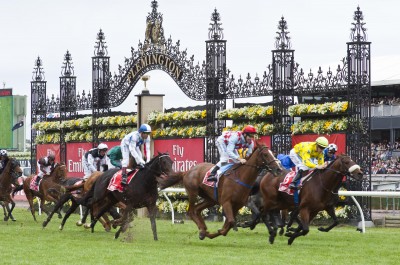Having a Flutter: The Melbourne Cup and the Australian Gambler

“In terms of prize money, the Melbourne Cup is worth more than the Grand National or any race in America, and it is far more popular in terms of national identity.” — Richard Waterhouse, ABC Radio, Nov 3, 2015.
An inspection of the hungry, jostling crowds gathering at the gates of the Flemington Race Course, Melbourne, gives a false sense of colour, order and, dare one venture it, glamour. It is another first Tuesday of the week of November, and the State is celebrating a holiday.
Few countries in the world could boast honouring a holiday in the name of a horse race that takes place over 3.2 kilometres. Since November 7, 1861, Melbourne has been the place for this spectacle of humankind and beast, in which the horses tend to behave far more impeccably than the indecorous spectators.
As Professor Emeritus Richard Waterhouse explained to ABC Radio last year, horseracing was English in inspiration, the “cultural baggage” that kept the colonists busy in entertainment and distraction.[1] Wealthy colonists eventually got serious about thoroughbred racing, which ranks as the third most patronised sport in Australia.
To encourage the element of chance, the horse race is also run in a handicap format, in which each horse is allocated a different weight depending on age and past form. As the National Museum of Victoria suggests, “This presents punters with the challenge of guessing which horse will overcome its handicap.”[2]
Mark Twain, when visiting Melbourne, noted something no less than a cult in practice in account “Following the Equator”. The Cup “is the mitred Metropolitan of the Horse-Racing Cult. Its race ground is the Mecca of Australasia.” In scribbling these words, he claimed to have seen nothing to rival such worship. “I can call to mind no specialized annual day, in any country, whose approach fires the whole land with a conflation of conversation and anticipation and jubilation. No day save this; but this one does it.”
The singular nature of the event in the Australian calendar is exemplified by the fashion. Why, the question might well be asked, would that matter at such a gathering? Much of this was put down to racing executives keen to keep the women interested, even as other entertainment options grew. In time, what mattered off the racing track was as important, if not more so, than what took place on it.
This has, in turn, spawned an industry of critics and advisors, generating fictional protocols about what should be embraced, or avoided, as the horses gather for the ultimate battle.
A list of the permitted points is offered in a Spring Racing Carnival segment.[3] Make sure you wear something neither too small nor big. “Practice wearing shoes that you can walk in all day long.” Keep an eye on what skin is exposed. “If you prefer a low cut top, drop the hemline down.”
This laundry list of items starts resembling equine grooming. We are, after all, beasts as well, in need of care. “Be polished – don’t forget your nails, scrub your heels and brush your hair.” This being Australia, it was important to remember sunscreen.
The dignity police, cutting their teeth on breakfast shows and the fashion segment of magazines, are also ever present, though carefully considered advice tends to go out the window the longer the sun, and the booze, start ravaging the punters.
Nonetheless, the Racing.com aficionados insist on the following injunctions: Avoid denim; avoid joggers, slippers and gumboots; do not expose your midriff, wear a miniskirt, or reveal tanned skin that resembles an overenthusiastic roast.
The matter is even stricter for those wishing to linger and twitter in the birdcage reserved for celebrities. Plumage, coming in the form of exotic, sometimes plainly idiosyncratic fascinators, is encouraged.
It can be painful to go through some of the academic churners who venture to see in the Melbourne Cup something markedly special, infused with pseudo-religious worth. Carole M. Cusack and Justine Digance attempt to see the Cup in terms of a “sociology of religion”, in which the sacred, having “collapsed into the secular”, left the way open for a rampant consumerism.[4]
Critics and commentators should not read too much into an event that ultimately worships a counterfeit decency in order to liberate inner desire. King Dollar, the bottle, and libido, ultimately come together in an extravaganza that exhausts itself by the day’s end.
What matters is how the Melbourne Cup permits a communing of beasts, where ample drink flows, and the flutter with a bet is made, often with friends or work colleagues. This is gambling as a collective effort, the one time in the year when many Australians become punters, and the lone addict can keep company.
Over the course of the day, the relevant spectacle is not that of dashing horses and their desperate jockeys dashing to the finishing line, but of collapsing punters, their fascinators and suits crumpled and soaked, flailing in mud and excreta.
Dr. Binoy Kampmark was a Commonwealth Scholar at Selwyn College, Cambridge. He lectures at RMIT University, Melbourne. Email: [email protected]

